Shock Index: A Simple and Effective Clinical Adjunct in Predicting 60-Day Mortality in Advanced Cancer Patients at the Emergency Department
- PMID: 32646021
- PMCID: PMC7370122
- DOI: 10.3390/ijerph17134904
Shock Index: A Simple and Effective Clinical Adjunct in Predicting 60-Day Mortality in Advanced Cancer Patients at the Emergency Department
Abstract
Deciding between palliative and overly aggressive therapies for advanced cancer patients who present to the emergency department (ED) with acute issues requires a prediction of their short-term survival. Various scoring systems have previously been studied in hospices or intensive care units, though they are unsuitable for use in the ED. We aim to examine the use of a shock index (SI) in predicting the 60-day survival of advanced cancer patients presenting to the ED. Identified high-risk patients and their families can then be counseled accordingly. Three hundred and five advanced cancer patients who presented to the EDs of three tertiary hospitals were recruited, and their data retrospectively analyzed. Relevant data regarding medical history and clinical presentation were extracted, and respective shock indices calculated. Multivariate logistic regression analyses were performed. Receiver operating characteristic (ROC) curves were plotted to evaluate the predictive performance of the SI. Nonsurvivors within 60 days had significantly lower body temperatures and blood pressure, as well as higher pulse rates, respiratory rates, and SI. Each 0.1 SI increment had an odds ratio of 1.39 with respect to 60-day mortality. The area under the ROC curve was 0.7511. At the optimal cut-off point of 0.94, the SI had 81.38% sensitivity and 73.11% accuracy. This makes the SI an ideal evaluation tool for rapidly predicting the 60-day mortality risk of advanced cancer patients presenting to the ED. Identified patients can be counseled accordingly, and they can be assisted in making informed decisions on the appropriate treatment goals reflective of their prognoses.
Keywords: 60-day survival; Stratification to Prevent Overcrowding Taskforce (SPOT); advanced cancer; emergency department; emergency physicians; shock index.
Conflict of interest statement
The authors declare no conflict of interest. The funders had no role in the design of the study; in the collection, analyses, or interpretation of data; in the writing of the manuscript, or in the decision to publish the results.
Figures
References
-
- Alfred F.C., Neal V.D., Norman A.D., William J.F., Lee G., William A.K., Joanne L., Robert K.O., Marilyn B., Anne D., et al. A controlled trial to improve care for seriously ill hospitalized patients. The study to understand prognoses and preferences for outcomes and risks of treatments (SUPPORT). The SUPPORT Principal Investigators. JAMA. 1995;274:1591–1598. - PubMed
Publication types
MeSH terms
LinkOut - more resources
Full Text Sources
Medical



